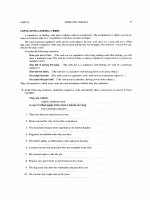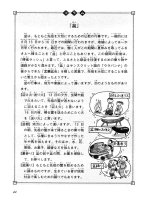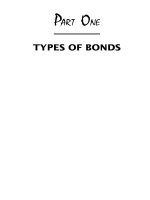Getting started in bonds 2nd edition phần 4 pps
Bạn đang xem bản rút gọn của tài liệu. Xem và tải ngay bản đầy đủ của tài liệu tại đây (431.76 KB, 31 trang )
Why MBSs Yield More
77
FIGURE 4.6 Principal erosion decreases income.
Drawing by Steven Saltzgiver.
A pool’s average life can change with changes in in-
terest rates. In the summer of 2002 the Lehman Broth-
ers Mortgage index had an average maturity of 6.31
years. A 30-year MBS with a 6% coupon had an average
life of 6.57 years, while a 30-year MBS with a 6
1
/
2
%
coupon had a 4.2-year average life.
The longer the security’s average life, the more price
volatility it will have. The shorter the average life, the
lower the security’s price volatility for a given change in
interest rates. This is like a diver bouncing on the end of a
diving board. The shorter the board is, the smaller the arc
from top to bottom of the board’s bounce. The longer the
board, the greater the distance between the tip of the
board’s high point and low point as the diver bounces on
the end. (See Figure 4.7.)
Since how quickly homeowners prepay their mort-
gages changes with interest rates, so does the MBS’s aver-
age life. As interest rates drop and homeowners refinance
more often, the average life shortens because you are get-
ting your principal back more quickly. So, the expectation
about how long the time will be before half of the princi-
pal is returned to you is shorter. The expected yield drops
because it is projected you’ll have less principal remaining
to earn you interest.
As interest rates rise, prepayments slow. The aver-
age life extends out into the future. It then is expected
that it will take longer before half the face value is paid
out to you.
MORTGAGE-BACKED BONDS
78
volatility
the characteristic
of having up and
down changes.
TABLE 4.2 Decreasing Income
Month Loan Face Value Income Earned
$25,000 $2,500.00
January 24,875 2,487.50
February 24,775 2,477.50
March 24,575 2,457.50
April 23,575 2,357.50
Negative Convexity
Besides the yield being affected, the problem with this
shortening and lengthening is that the MBS becomes
more responsive to interest rate moves when interest
rates rise and bond prices are falling. Its price drop ac-
celerates and falls faster than other fixed income invest-
ments. Then, when interest rates fall and bond prices are
rising, the MBS becomes less responsive, and its price
rise is slower relative to other fixed income investments.
An MBS is like a big rock. Its additional mass causes
it to fall faster; and attaching a balloon to it will cause it to
rise more slowly.
Why MBSs Yield More
79
FIGURE 4.7 Longer average life (maturity); more volatility.
Drawing by Steven Saltzgiver.
COLLATERALIZED MORTGAGE
OBLIGATIONS (CMOs)
Wall Street loves to slice and dice securities, forever creat-
ing new entrants in the investment-of-the-month club: ar-
tificial financial alternatives.
In the 1990s the nouveau product du jour was the
collateralized mortgage obligation (CMO). Before the
CMO was conceived, institutional investors backed away
from MBSs, complaining that the securities’ negative con-
vexity could cause them to underperform. So, Wall Street
conceived and delivered the CMO.
The Making of a CMO
While an MBS is a pool of mortgages, a CMO is a pool of
MBSs that is then cut up into component parts. Asset-
backeds and corporates also package together their securi-
ties, slice and dice, and sell them as CDOs (collateralized
debt obligations) in two types: CBOs (collateralized bond
obligations) and CLOs (collateralized loan obligations).
You can think of a CMO as an apple pie. This pie is
so skillfully cut that one piece would have all the choice
apples, while another piece would consist of only butter
and sugar, leaving yet a third piece with mealy, worm-
infested apples. Woe to the diners who gave only a cursory
glance at the crust before they swallowed.
All of a CMO’s pieces (aka traunches) are interre-
lated, so a change in one causes all the others to change as
well. You need to understand how all the pieces behave,
not just the one you’re buying.
When CMOs first came to market, they often had
only four traunches. (See Figure 4.8.) The face value of
each traunche was paid off sequentially. Traunche A was
paid off first, then traunche B, and so on.
As time went on CMOs got even harder to decipher
because as the type of traunches got more complex, the
number of traunches increased exponentially. Some
CMOs had as many as 60 traunches, and it became next
to impossible to figure out how all these funky traunches
interacted. As you can see in Figure 4.9, we no longer
have four neatly paying sequential traunches.
MORTGAGE-BACKED BONDS
80
collateralized
mortgage
obligations
(CMOs)
a security made
up of mortgage-
backed
securities. It is
split up into
pieces called
traunches that
are designed to
have specific
volatility and
maturity
characteristics.
traunche
division within a
CMO that has its
own unique
characteristics
and is sold as a
separate security.
Some traunches would suddenly completely pay
down. Some would lose half their value in a week. Some
would decline in value instead of rising when interest
rates fell. Some traunches jumped. It’d be like you were
standing behind a wall and all of a sudden it jumped out
of the way and there was a train bearing down on you.
Collateralized Mortgage Obligations (CMOs)
81
FIGURE 4.8 Collateralized mortgage obligation (CMO)
traunches.
FIGURE 4.9 Complex collateralized mortgage obligation (CMO).
We’re not going to get into the complicated analytics
involved in understanding a complex CMO’s schematics
here; that’s another book. Suffice it to say that many in-
vestors were hurt by these bonds, and they now affection-
ately say that CMO stands for “Count Me Out.” It’s not
hard to understand how CMOs got such a bad name. It
isn’t necessarily their fault—like any adolescent, they just
aren’t understood. Remember: Don’t buy something if you
don’t fully understand it.
MORTGAGE-BACKED BONDS
82
83
5
Going Global:
International Bonds
T
his chapter travels beyond our country’s bor-
ders. Throughout time, countries have cycled
through different postures toward each other,
such as isolationist or expansionist. Today’s trend is
globalization. This environment of openness is most ob-
viously illustrated by the formation of the European
Union (EU) alliance and its adoption of a single, com-
mon currency—the euro (C
=
)—in 1999. At least eco-
nomically, everyone around the world is trying to be
one big happy family. Pools of capital are there for
anyone who cares to take a dip. Investment opportuni-
ties of every type are available in every language. In
1993, 54% of the world debt was outside the United
States, so certainly fixed income opportunities abroad
abound.
When you invest outside the United States, you
must account for the currency risk and sovereign risk
involved. We will review some of the choices and risks
involved in investing overseas, but our stay will be
brief since this is an area where it can be best to have a
professional as your guide. It is easier for these in-
vestment professionals who devote their resources and
time to:
Chapter
European
Union (EU)
begun in 1950,
the EU has 15
member states,
with 13 others
soon to be added.
It includes
countries that
have not adopted
the euro as
their domestic
currency.
✔ Track down elusive information.
✔ Decode foreign accounting practices and finan-
cial documents.
✔ Understand the intricacies of interrelated cur-
rency movements.
Even if international investing doesn’t interest you,
you should be aware that you may be investing interna-
tionally without realizing it when you buy domestic cor-
porate bonds. Companies such as Ford, PepsiCo, and IBM
have operations all around the globe. When you invest in
such global conglomerates, your investment return is
likely to be impacted by the same factors that affect inter-
national securities, such as currency exchange rates,
health of the foreign economies, and trade relations with
the countries where these companies do business.
If you are interested in investing in international
bonds, bonds issued by foreign governments, or bonds of
companies domiciled in foreign countries, it is probably for
the unique opportunities they can offer you. A major con-
sideration is the chance to diversify your portfolio. Diversifi-
cation is most effective when your various investments are
not highly correlated—they either react to different events
or react differently to the same events. This is often the case
with bonds issued by other countries. They can be impacted
by events that our own bonds don’t even notice. For exam-
ple, our bonds have little if any reaction to France’s employ-
ment figures, but their domestic bonds can react quite
dramatically to the news. The less correlated a country’s in-
INTERNATIONAL BONDS
84
The opposite of correlated is to be inversely related,
which means to move in the opposite direction or be-
have in an opposite manner. For example, the behav-
ior of a hungry cat and a hungry horse when they see
food will be highly correlated (they’ll both move to-
ward the food), whereas the behavior of a rock and a
balloon released from the top of the Empire State
Building are inversely related.
euro (C
=
)
common
currency shared
by 12 European
countries that
agreed to
function as one
economic and
financial unit
beginning in
1999. The
monetary system
is governed by
one central bank.
Trade and
employment
barriers have
been dropped.
currency
risk
the risk that the
currency your
foreign bond is
issued in will
appreciate in
value so your
bond’s proceeds
will be converted
back into fewer
dollars than they
would have been
before.
vestments are with ours the more different their behavior
will be. This means that the opportunity for diversification
will be greater, but so too could be the opportunity for risk.
Another reason to buy bonds beyond our borders is
for the chance to earn higher interest rates. Higher-quality
issuers (developed nations, such as those countries in the
G-8) tend to be more highly correlated with our economy
(since we’re considered a developed nation). Therefore,
their interest rates tend to be highly correlated with our
own. When you invest in securities issued in these coun-
tries the primary benefit you are looking for is currency
diversification, whereas emerging markets (often known
as NICs or newly industrialized countries) offer a wider
range of diversification, as well as greater chances for in-
come pickup and capital gains. However, this also means
they offer a greater chance for loss.
INTERNATIONAL FIXED
INCOME ALTERNATIVES
As for international bonds, investing in them is gener-
ally broken down into two categories: U.S. pay (dollar-
denominated) and foreign pay (denominated in a currency
other than U.S. dollars).
There is no currency risk with U.S. pay bonds for
U.S. investors; however, you also lower the investment di-
versification impact because you aren’t diversifying out of
U.S. dollars. One of the most straightforward ways to in-
vest in foreign entities is through Yankee bonds. Foreign
banks and foreign companies issue Yankee bonds in the
U.S. market. They are, therefore, registered with the Secu-
rities and Exchange Commission (SEC) and underwrit-
ten by a domestic syndicate. Because these bonds are
listed and trade in our domestic market, they often offer
more liquidity and easier access to information, making
them an attractive alternative for individual investors.
There is a fairly new type of security known as
global bonds. These bonds are issued in a number of dif-
ferent countries simultaneously. In each country they are
issued in the country’s own currency. They are registered
International Fixed Income Alternatives
85
sovereign
risk
the risk that the
government
where the bonds
are issued will
take actions that
will hurt the
bond’s value.
correlated
objects are said
to be correlated
when their
actions tend to
resemble one
another; objects
that are not
correlated react
dissimilarly to
events.
in each country where they are issued, so in the United
States they are registered with the SEC. Securities have to
meet certain criteria and standards in order to be regis-
tered with the SEC, so this gives investors a certain peace
of mind.
You need to be aware that even though IBM is a U.S.
corporation, IBM Netherlands could be a separate and for-
eign entity whose bonds would be held to standards that
could be different from the SEC’s. Eurobonds and Eu-
rodollar bonds also are regulated by the issuing country’s
guidelines, not the SEC’s. Those differences may or may
not be important. To protect yourself when you are buy-
ing foreign bonds, there are several questions you need to
ask yourself:
✔ Who issued the bond?
✔ What market is the bond traded in?
✔ Where is the entity that issued the bond domi-
ciled?
Once you have answered these questions, you can
use that information to delve deeper into what legal, ac-
counting, and regulatory standards apply to this issue.
The legal questions are innumerable:
✔ What happens if the issuer goes bankrupt?
✔ Is there a bankruptcy court to govern the process
most profitably or will the assets just be sold at
fire sale prices, leaving investors with next to
nothing?
✔ Will the courts rule on issues that protect share-
holder rights?
Regulatory standards refer to what the issuer’s
investment governing body, like our SEC, requires is-
suers to do and uphold. The standards may be much
more lax than our own, leaving room for graft or misun-
derstanding.
There are other matters to grapple with. The
length of the year you use to calculate the interest can
INTERNATIONAL BONDS
86
G-8
eight developed
nations that have
formed a loose
economic alliance
(formerly the G-
7). Their
economies and
interest rates
tend to move in
the same
direction. The G-8
includes: Canada,
France, Germany,
Great Britain,
Italy, Japan,
Russia, and the
United States.
newly
industrialized
country (NIC)
emerging
market; offers
diversification
and profit
potential but
also risk.
Yankee
bonds
dollar-
denominated
bonds issued in
the United States
by foreign banks
and corporations.
be different. Taxation can be an issue. When do you
convert back into dollars? Furthermore, you have to
wait until the foreign bond is seasoned before you buy
it. The quandaries go on and on. This arena can be fraught
with painful leg traps for the unsuspecting individual
investor.
RISKS OF INTERNATIONAL INVESTING
As mentioned at the beginning of our discussion about
international investing, when you invest in foreign bonds
(or stocks), you add two more types of risks to the menu:
currency risk and sovereign risk. Because of the added
complexity these risks introduce, many investors choose
to engage professional financial advisers when they ven-
ture abroad to participate in foreign markets. Even if you
do hire an expert, it is still important that you under-
stand the risks involved so that you know what questions
to ask and can guide your adviser toward what is appro-
priate for you.
Currency Risk
When you invest in securities that pay interest and princi-
pal in some currency other than the U.S. dollar, you take
on the added uncertainty of currency risk. This is the risk
that the foreign currency will depreciate (go down in
value) against the dollar while you are invested there,
which is the same as saying that the dollar will appreciate
(rise in value) versus that currency.
If the foreign currency you’ve invested in depreciates
versus the dollar, it would take more foreign currency to
buy the same number of U.S. dollars, because the foreign
currency is worth less (it has depreciated in value). (See
Figure 5.1.)
As long as you stay in the foreign currency, there’s
no problem with the dollar appreciating. The problem
comes when you try to convert your earnings back into
U.S. dollars. For example, if you earned 12% interest but
Risks of International Investing
87
Securities
and Exchange
Commission
(SEC)
federal agency
that regulates the
securities
industry. It
makes rules to
discourage fraud,
and then polices,
arbitrates, and
punishes
misconduct. It
was created by
the Securities
Exchange Act of
1934 to enforce
the Securities Act
of 1933.
underwritten
when an
investment bank
buys a new
issue, assumes
the market risk,
and attempts to
resell it to the
public; a
syndicate
underwrites the
new issue.
the currency depreciated 10% versus the U.S. dollar, when
you convert your earnings back into U.S. dollars, you find
that you actually made only 2%.
Of course, the dollar can also depreciate (foreign
currency appreciates). In this case, your investment re-
turn is increased because the interest or principal pay-
ment converts into more dollars. Let’s say you earned 12%
interest and the currency appreciates 10%; your total re-
turn would be 22%.
Currency Conversions
The exchange rate is also known as the FX rate (FX stands
for foreign exchange). Fortunately for U.S. investors, all
foreign exchange markets quote their currency in terms of
the U.S. dollar. Unfortunately, they don’t all quote it in the
same way.
Almost all currencies quote their value in terms of
how many currency units equal one dollar. For example,
7.5 deutsche marks (DM) = $1; 133 yen = $1. However, a
few currencies quote their value in terms of how many
dollars equal one unit of their currency, most notably the
British pound and Australian dollar. For example, $3 = 1
British pound. The Canadian dollar is quoted in terms of
both U.S. dollars per Canadian dollars and Canadian dol-
lars per U.S. dollars. International traders look at cross
INTERNATIONAL BONDS
88
Yen Depreciates, Dollar Appreciates
Yen U.S. Dollars
Yen Appreciates, Dollar Depreciates
orBuys
¥¥
¥
¥
¥
¥
¥
FIGURE 5.1 Currency risk.
Buys
Buys
global
bond
bond issued in
several countries’
currencies
simultaneously.
Eurobond
bond under-
written by banks
and investment
firms from
several different
European
countries.
Eurobonds can
be denominated
in any currency.
They are sold to
investors outside
the country
whose currency
pays the issue’s
principal and
interest.
currency rates, which show the exchange rates between a
number of currencies (Table 5.1).
Let’s say you own Anleihe der Bundesrepublik
Deutschland (Bunds) 4
3
/
4
% 7/4/08, which paid 4,750 DM
annually—now 2,428.64 euros (C
=
). When you decide to
convert the July 4, 2002, interest payment on July 10, the
FX rate is .9884 (that’s dollars per euro). So, you will re-
ceive $2,400.47, found by multiplying C
=
2,428.64 by
.9884. When you convert your next interest payment, let’s
say the exchange rate is .9412 (do not use this as a fore-
cast—I’m just randomly pulling numbers out of the air);
so you would then receive $2,285.84. You can see how
currency fluctuations can impact the U.S. dollar value of
your foreign investments.
Computing currency exchanges can be confusing;
it’s easy to invert the calculations if you don’t do it all the
time. At Bloomberg.com there is a currency calculator,
where you just put in the currencies you are concerned
with and out pops the answer!
The monetary policy, economic environment, and
political developments in a country all play a role in its
currency’s valuation. A high inflation rate can hurt a cur-
rency because investors don’t want to own a currency
whose value is being inflated away. Relatively high real in-
terest rates can help a country’s currency. There is also
the risk that a country may institute capital controls. This
means it decrees that the currency is no longer convert-
Risks of International Investing
89
If you own dollars and are looking to invest or
travel abroad, you want either the dollar to appreci-
ate/get stronger or the foreign currency to depreci-
ate/weaken, so your dollars will have more
purchasing power outside the United States. If you
own foreign investments and would like to repatri-
ate them back into dollars, you hope the dollar
weakens or the currency you’re invested in strength-
ens, so each unit of the foreign currency can buy
more dollars.
Eurodollar
bond
a bond whose
principal and
interest are paid
in U.S. currency
held in foreign
banks, usually
European banks.
They are not
registered with
the SEC.
seasoned
securities have
been outstanding
and traded in the
secondary market
for a while.
depreciate
decline in value.
appreciate
the investment
value rises
higher.
90
TABLE 5.1 Cross Currency Rates
USD GBP CHF JPY CAD
AUD EUR NZD DKK SEK
SEK
9.3367 13.98 6.1777 7.7001 6.1406 5.3625
9.0631 4.6515 1.2193 SELF
DKK
7.6574 11.47 5.0666 6.3151 5.0361 4.3980
7.4330 3.8149 SELF 0.8201
NZD 2.0072 3.0060 1.3281 1.6554 1.3201
1.1529 1.9484 SELF 0.2621 0.2150
EUR
1.0302 1.5428 0.6816 0.8496 0.6775
0.5917 SELF 0.5132 0.1345 0.1103
AUD
1.7411 2.6075 1.1520 1.4359 1.1451 SELF
1.6901 0.8674 0.2274 0.1865
CAD 1.5205 2.2771 1.0061 1.2540 SELF
0.8733 1.4760 0.7575 0.1986 0.1629
JPY
121.26 181.59 80.23 SELF 79.75
69.64 117.70 60.41 15.84 12.99
CHF
1.5114 2.2634 SELF 1.2464 0.9940 0.8680
1.4671 0.7530 0.1974 0.1619
GBP
0.6677 SELF 0.4418 0.5507 0.4392 0.3835
0.6482 0.3327 0.0872 0.0715
USD SELF 1.4976 0.6617 0.8247 0.6577
0.5744 0.9707 0.4982 0.1306 0.1071
USD U.S. dollar GBP British pound
CHF Swiss franc
JPY Japanese yen CAD Canadian dollar
AUD Australian dollar
EUR Euro
NZD New Zealand dollar DKK Danish krone
SEK Swedish krona
June 2002, Bloomberg.com.
ible. It is isolating its currency and financial system from
everyone else because it is in big trouble and views this as
the only way to protect itself. Spain instituted capital con-
trols in the early 1990s. Russia seems to change the rules
daily. Capital controls is actually an example of both cur-
rency risk and sovereign risk, which leads us to our next
discussion.
Sovereign Risk
Sovereign risk is at work when the Peruvian government
decides to nationalize the coffee operations you just in-
vested in, leaving your investment worthless. Sovereign
risk rears its head when the Russian government decides
to print rubles as if they were manufacturing tissue paper.
Sovereign risk ensnares you when militant factions topple
the democratic government in order to institute anarchy.
Think back over the past hundred years at how
many governments and companies have come and gone.
Very few enterprises have been around for as long as their
investors envisioned. With boundaries being constantly
redrawn, trying to keep a current globe in your den has
been an expensive task. The theme for humankind’s re-
cent history has certainly been “temporal.” With all this
unpredictable change, you can see how not understanding
what’s going on could be financially dangerous.
Sovereign risk can stalk the unsuspecting foreign in-
vestor because we are far away and aren’t aware of all that
is going on. Our naïveté is as ingrained as our way of
looking at the world; we often don’t have a full apprecia-
tion of the differences in culture and psychology. Princi-
ples we take for granted like freedom of expression and
social justice may be unknown in that country.
In addition, the rules of business may be very differ-
ent. That country’s accounting practices may be so totally
obscure to us that a company that looks solvent may actu-
ally be operating in the red according to our own stan-
dards. Contracts may not carry the same legally binding
clout that they do in the United States and may be ignored
on a whim. Unfavorable taxation could result in any in-
come advantage being taxed away.
Risks of International Investing
91
real
interest rate
what you’re left
with after
inflation deflated
your return (real
rate of return
equals nominal
interest rate
minus inflation
rate).
Foreign investing can be a labrinyth of the un-
known, rife with hidden pitfalls for the uninformed in-
vestor, and often the information needed to clear up the
confusion is very hard to secure. Besides the economic
dilemmas, you may also find it difficult to monitor social
issues. Companies don’t usually advertise in their reports
that they use child labor or operate unsafe sweatshops.
Other countries may not police or care about these issues.
Unless you made a visit you might never know your
money is supporting undesirable business practices.
Currency risk and sovereign risk are the reasons why
the vast majority of investors choose to invest in countries
with very similar cultures and those whose currencies
tend to highly correlate with our own, like Canada. These
risks are also why they choose to use investment profes-
sionals who dedicate their full-time efforts to understand-
ing the nuances of foreign investment environments.
There are myriad mutual funds, as well as investment pro-
fessionals, that specialize in the global arena. This is one
area where it can pay to hire a specialist.
INTERNATIONAL BONDS
92
93
6
Paid to Wait:
Convertible Bonds
T
his chapter moves away from traditional bonds
and explores a type of hybrid security. Like a
mixed metaphor, convertible bonds look and act
like a bond, but they can also look and act like common
stock. Investors are attracted to convertibles because they
pay an enticing and steady income while you wait for the
stock price to move higher. If it does move, you’ve locked
in a purchase price.
Convertible bonds (aka converts) are similar to tra-
ditional fixed income investments in that they pay income
twice a year, have a maturity date, and are sometimes
callable. In fact, in the Wall Street Journal they appear with
the listed corporate bonds. They are different from tradi-
tional bonds in that they pay interest and offer the option
to convert the bonds into a certain number of the issuer’s
common stock shares at a specified price. How many
shares of common stock each convertible bond can be ex-
changed for when it is converted is set by the convert’s
conversion ratio when the convertible is issued.
Since convertibles are bonds that can become stock,
the security’s value responds to changes in the common
stock’s price and the credit quality of the company. Inter-
est rates have little impact because convertibles tend to
have low yields.
Chapter
conversion
ratio
set when a
convertible bond
is issued, this
ratio calculates
how many shares
of common stock
each convertible
bond can be
exchanged for
when the bond
is converted
(conversion ratio
equals par value
divided by
conversion price).
Xmart
Security Yield
Stock 0%
Convert 6%
Bond 8%
In the preceding example, you can see that converts
tend to yield more than the common stock and straight
debt tends to yield more than the convert. It also illus-
trates why converts are so popular. A convert gives you
potential equity price participation and a higher yield. So
if the common stock doesn’t move you’re still earning an
attractive yield.
The convertible’s long-term stock option (the option
to convert the bond into shares of stock) is valuable, so
the company can pay lower interest than on the com-
pany’s straight debt (a traditional bond).
The conversion price is established at issue. It is usu-
ally much higher than the stock price is when the con-
vertible bond is issued. For example, imagine that
International Flag Inc. convertible bonds are issued on
September 10, 2003, when the common stock is trading at
$15 per share. Their conversion price is $25 per share. If
you decide to convert, you trade in the convertible bond
and pay $25 a share for the common stock; you then own
the common stock instead of the convert. Converting into
common stock is obviously not something you would do
until the stock price rises higher than the conversion
price of $25 per share.
If you are familiar with options, it may help to
think of a convertible as a bond trading with an attached
stock (call) option. When the bond is issued, the con-
vertible’s conversion price is like an out-of-the-money
call option’s strike price. (See Figure 6.1.) At this point
the conversion option is not worth much because the
likelihood of its being exercised is remote. The conver-
sion option doesn’t appreciate much in value until the
underlying stock price gets closer to the conversion
(strike) price, and it becomes more likely that the con-
version option will be exercised.
CONVERTIBLE BONDS
94
call
an option
contract that
gives the buyer
the right to
purchase a
security from the
owner at a
specific price
before the
contract’s
expiration date.
out-of-the-
money
the futures or
option contract
has no intrinsic
value; if it were
exercised today
the contract
holder would
lose money.
strike
price
price stipulated
in a futures or
option contract
that the contract
can be exercised
at (i.e., the price
the security can
be put or called
at).
When the stock’s market price rises above the con-
version price and the stock is now yielding more than the
convertible, the convertible’s option is in-the-money. As
long as this is the relationship (Figure 6.1), the convert-
ible price moves in lockstep with the underlying stock’s
value price. This is because now it is profitable to convert
the bond into the common stock. The convertible has be-
come a proxy for the stock and so will mimic the com-
mon stock’s behavior.
Most convertibles are callable. When the company
decides to call a convertible, it must notify you ahead of
time so that you have time to convert the bond if you
wish. Convertible bond calls may be expressed as a con-
ditional statement. For example, “This bond is non-
callable for four years from date of issue unless the
common stock sells at 140% of the conversion price for
30 consecutive trading days.” In other words, if the com-
mon stock’s price trades at levels 40% above the convert-
ible’s conversion price for 30 trading days straight, the
issuer can call the convert. So, if the conversion price is
$25, and the stock price trades at $35 for 30 trading
days, the company could call the bond.
If a company files for bankruptcy, convertible
Convertible Bonds
95
FIGURE 6.1 Options: in-, at-, and out-of-the-money.
Call
Market
Price
Underlying
Security
Price
Put
Market
Price
Underlying
Security
Price
exercise
to use the right
you purchased in
a futures or
option contract.
in-the-
money
the price of the
underlying
security has
moved so that if
you exercised
the option you
would make
money. The
contract has
intrinsic value.
CONVERTIBLE BONDS
96
Options
When you buy an option, you are paying for the op-
portunity to do something in the future should you so
choose. For example, when you buy a call, you are
paying for the chance to buy a commodity like corn,
or a stock, or a bond at a certain price. (We’ll refer to
just bonds here.) This price is called a strike price. You
are hoping the price of the bond you’ve bought a call
on will rise above the strike price, so you can buy the
security at a lower-than-market price. If the price does
move higher, you could immediately exercise the op-
tion, buy the bond, and sell it at the higher market
price for a profit. Options have an expiration date after
which the contract ceases to exist, so the market has
to move higher before then for you to make any money.
So, when you buy a call, you are buying the op-
tion to purchase the bond at a certain price. When
you sell a call, you receive a call premium (cost of the
option) from the call buyer. You are giving that per-
son the right to call the bond away from you. You are
hoping the price doesn’t move higher so the person
won’t call your security away at a lower-than-market
price. You’ll be able to keep the bond, and you’ll have
made money from having sold the now worthless call.
Selling a call is also known as writing a call.
Call options involve the right to call the bond
away from the owner. Put options involve the right to
force someone to buy your bond at a higher-than-
market price. When you buy a put, you are paying for
the right to sell your bond at a certain price to the per-
son who sells you the put. You are protecting yourself
from having the price of your security drop. If the
price does fall, you can sell your bond at a higher-
than-market price, limiting losses. On the other hand,
the put seller is hoping the price of the bond won’t fall,
so the premium you paid him/her will be clear profit
without any consequences. The put seller doesn’t want
to have to pay above-market prices for the bond.
proxy
stand-in for; e.g.,
an in-the-money
convertible bond
can be
exchanged for
stock, so it is
considered to be
an alternative
and equivalent
form of the
common stock.
put
contract that
enables the
option holder to
sell a security to
the other party at
a set price until
the contract
expires.
bondholders are usually behind traditional bond in-
vestors and in front of preferred and common stock
owners in the line of lien holders trying to claim a piece
of the failing company’s assets.
This seniority tends to provide convertibles with
more downside price protection than the company’s pre-
ferred or common stock because of its place in the capital
structure—where it stands in its claim on company assets
in the case of bankruptcy.
Convertibles are also an attractive common stock al-
ternative for investors who plan to hold the securities in a
margin account. The security offers participation in the
common stock’s upside while the interest earned helps to
defray the margin interest expense. (See Figure 6.2.)
Convertible Bonds
97
Options themselves can be traded in the sec-
ondary market once the contract has been written.
Their value is based on how much time there is until
the option expires (theta), how volatile the market is
(vega), and where the market price is versus the
strike price. The option is worth more the more time
there is until expiration, the more volatility there is
in the market, and the more in-the-money it is. This
last point refers to the relationship between the
strike and market price. The strike price does not
change. When the contracts are written a call’s strike
price is lower than the market price, and a put’s
strike price is above the market price. The options
are originally out-of-the-money. This means that if
you exercised the option immediately (you said,
“Yes, I want to call/put the bond”), you would lose
the money you paid for the option. At-the-money
means the market price equals the strike price. In-
the-money means if you exercised the option, you’d
make money. The option is said to have intrinsic
value because it can be “converted” into cash. A call
is in-the-money when the security’s market price is
above the strike price. A put is in-the-money when
the security’s market price is below the strike price.
margin
account
investment
account where
the investor
borrows money
from the
investment firm
in order to buy
securities, paying
a higher interest
rate on the
money borrowed.
WHEN TO BUY CONVERTS
If you don’t think you’ll ever buy convertibles, skip this sec-
tion. But if the convertible concept intrigues you, read on.
There’s some math to follow. Plan on reading it a couple of
times, and don’t worry if it doesn’t come clear right away.
It makes sense to buy a convertible that is not yet
convert-able if either you think it will be in-the-money in
the near future, or the yield is high enough to make it
worth the wait to see if the convert will be in-the-money
at some point.
To help decide if the latter is the case, follow these
three steps:
1. Calculate the convert’s yield advantage versus the
common stock yield.
CONVERTIBLE BONDS
98
FIGURE 6.2 Convertibles help defray margin expenses.
Margin expense
Net margin borrowing cost
Amount you earn
2. Calculate how much you are paying for the con-
version option; it’s the difference between the
price you are paying and the price you would pay
if the bond weren’t convertible. It is known as the
(convertible) premium.
3. See if the yield advantage (step 1) is greater than the
premium you are paying (step 2) for the ability to
convert the bond into stock.
Pretend today’s date is 9/30/05. We’re looking at
Snafu Co.
Common Stock
Price: 31
5
/
8
Annual dividend: $1.25
Convertible Bond
Issued in 2004 BB-rated
Coupon: 7
1
/
2
% Maturity: 9/10/14
Current market price: 97 Callable 4/2/06 at 105.08
Conversion price: $44.25
Conversion ratio: 22.599
Remember, the conversion ratio tells you how many
shares of common stock each convertible bond can be ex-
changed for when it is converted. If it is not given to you,
you can calculate it:
Conversion ratio = Par value ÷ Conversion price
= $1,000 ÷ $44.25
= 22.599
This means each Snafu convertible bond can be ex-
changed for 22.599 shares of Snafu common stock. In or-
der to make a buying decision, take the above information
through the following steps:
When to Buy Converts
99
(convertible)
premium
how much more
you have to pay
for a convert
over and above
the price it would
cost if it were a
straight bond.
The premium is
expressed as a
percentage of the
convert’s
theoretical value.
The reason for
the premium
includes such
factors as the
ability to convert
the bond into
common stock
and the ability to
buy it on margin.
Step 1: Find the Yield Advantage
Start by calculating the common stock’s yield:
Stock yield = Dividend ÷ Current price
= $1.25 ÷ 31.625
= 4%
Then calculate the convertible’s yield:
Convert current yield = Coupon ÷ Current price
= 7
1
/
2
% ÷ 97
= 7.7%
To calculate the convertible’s yield advantage, sub-
tract the stock’s yield from the convert’s yield:
Yield advantage = Convert yield – Stock yield
= 7.7% – 4%
= 3.7%
Step 2: Find the Convertible’s Premium
Start by calculating what the bond’s theoretical price
would be if you stripped off the conversion option, so it
became a straight bond. This cannot really be done—it’s
just a theoretical concept, so that you can compare it with
the convert’s current price to see the value of the option.
This theoretical price is known as parity.
Parity = Current stock price ×Conversion ratio
= 31.625 ×22.599
= $714.69
Then divide the current price by the theoretical price
(parity):
Premium = Bond’s current dollar value ÷ Parity
= $970 ÷ $714.69
CONVERTIBLE BONDS
100
parity
a convertible
bond’s theoretical
value if it were a
straight bond
without the
conversion
option.
= 35.7%
= 1.357 = 35.7% premium
You subtract 1 from 1.357 and your result is the %
change: 35.7%. You can also use this method to find per-
centage increases. Say you had $5,000 invested and it
earned 5%. To calculate its value in one year you would
multiply $5,000 times (1 + .05):
$5,000×1.05 = $5,250
This premium shows you how much the bond is
trading above the bond’s theoretical value at the conver-
sion price (Figure 6.3). The higher the percentage the
bond’s actual value is above the theoretical value (parity),
the further you need the common stock’s price to rise be-
fore you can convert the bond.
Be careful not to confuse this use of the word
When to Buy Converts
101
FIGURE 6.3 Market price/parity relationship.









